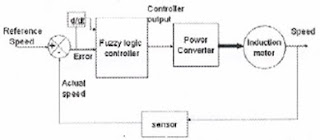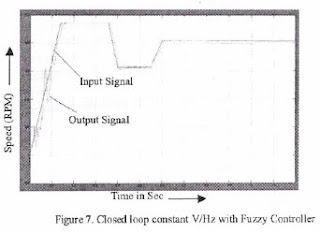Paper presentation: A HIGH PERFORMANCE INDUCTION MOTOR DRIVE SYSTEM USING FUZZY LOGIC CONTROLLER
A HIGH PERFORMANCE INDUCTION MOTOR DRIVE SYSTEM USING FUZZY LOGIC CONTROLLER
ABSTRACT
Abstract- Basically, the motor drive system comprises a voltage source inverter-fed induction motor (VSIM): namely a three-phase voltage source inverter and the induction motor. The squirrel-cage induction motor voltage equations are based on an orthogonal d-q reference-rotating frame where the coordinates rotate with the controlled source frequency. The paper presents a novel fuzzy logic controller for high performance induction motor drive system. The inputs to the fuzzy logic controller are the linguistic variables of speed error and change of speed error, while the output is change in switching control frequency of the voltage source inverter. In this paper a comparison between fuzzy logic controller and traditional PI controllers are presented. The results validate the robustness and effectiveness of the proposed fuzzy logic controller for high performance of induction motor drive. Simulink software that comes along with MATLAB was used to simulate the proposed model.
I. INTRODUCTION
Simulink induction machine models are available in the literature [1-2], but they appear to be black boxes with no internal details. Some of them in [1-2] recommend using S functions, which are software source codes for Simulink blocks. This technique does not fully utilize the power and ease of Simulink because S-function programming knowledge is required to access the model variables. Another approach is using the Simulink Power System Block set [3] that can be purchased with Simulink. This block set also makes use of S-functions and is not as easy to work with as rest of the Simulink blocks. Reference [4] refers to an implementation approach similar to the' one in this paper but fails to give any details. In this paper, a modular, easy to understand Simulink induction motor model is described. With the modular system, each block solves one of the model equations.
Though induction motors have few advantageous characteristics, they also posse's nonlinear and time-varying dynamic interactions [5-6], Using conventional PI controller, it is very difficult and complex to design a high performance induction motor drive system. The fuzzy logic control (FLC) is attractive approach, which can accommodate motor parametric variations and difficulty in obtaining an accurate mathematical model of induction motor due to rotor parametric and load time constant variations.
The FLC is a knowledge-based control that uses fuzzy set theory and fuzzy logic for knowledge representation [7]. This paper presents a novel fuzzy logic controller suitable for speed control of induction motor drives.
II. SIMULINK IMPLEMENTATION
One of the most popular induction motor models derived from this equivalent circuit is Krause's model [6]. An induction machine model can be represented with five differential equations. To solve these equations, they have to be rearranged in the state-space. form,
X=Ax+b Where X=[Fqs FdsFdr Fdr r] T is the state vector.
The inputs of a squirrel cage induction machine are the three-phase voltages, their fundamental frequency, and the load torque. The outputs, on the other hand, are the three phase currents, the electrical torque, and the rotor speed. The d-q model requires that all the three-phase variables have to be transformed to the two-phase synchronously rotating frame. Consequently, the induction machine model will have blocks transforming the three-phase voltages to the d-q frame and the d-q currents back to three-phase. The induction machine model implemented in this paper is shown in Fig. I. It consists of five major blocks: the o-n conversion, abc-syn conversion, syn-abc conversion, unit vector calculation, and the induction machine d-q model blocks. The following subsections will explain each block.
A. O-N Conversion Block:
This block is required for an isolated neutral system, otherwise it can be bypassed. The transformation done by this block can be represented as follows:
B. Unit Vector Block Calculation
Unit vectors cos teta*e and sin teta*e are used in vector rotation blocks, "abc-syn conversion block" and "syn-abc conversion block". The angle teta*e is calculated directly by integrating the frequency of the input three-phase voltages, teta*e.
The unit vectors are obtained simply by taking the sine and cosine of Be' This block is also where the initial rotor position can be inserted, if needed, by adding an initial condition to the Simulink "Integrator" block. Note that the result of the integration is reset to zero each time it reaches2n radians so that the angle always varies between 0 and 2n.
C. abc-syn con version block:
To convert three-phase voltages to voltages in the two phase synchronously rotating frame, they arc first converted to two-phase stationary frame using (3) and then from the stationary frame to the synchronously rotating frame using
where the superscript "s" refers to stationary frame.
D. syn-abc conversion block:
This block does the opposite of the abc-syn conversion block for the current variables using (5) and (6) following the same implementation techniques as before.
E. Induction machined-q model block:
The resulting model is modular and easy to follow. Any variable can be easily traced using the Simulink 'Scope' blocks. The blocks in the first two columns calculate the flux linkages, which can be used in vector control systems in a flux loop. The blocks in Column 3 calculate all the current variables, which can be used in the current loops of any current control system and to calculate the three-phase currents. The two blocks of Column 4, on the other hand, calculate the torque and the speed of the induction machine, which again can be used in torque control or speed control loops, These two variables can also be used to calculate the output power of the machine.
III. OPEN-LOOP CONSTANT V/HZ OPERATION
Fig. 5 shows the implementation of open-loop constant V1Hzcontrol of an induction machine. This figure has two new blocks: command voltage generator and 3-phasePWM inverter blocks. The first one generates the three-phase voltage commands, and it is nothing more than a "syn-abc" block explained earlier. The latter first compares the reference voltage, Vref to the command voltages to generate PWM signals for each phase, then uses these signals to drive three Simulink "Switch" blocks switching between +VJ2 and -Vd/2 (Vd: dc link voltage). The open-loop constant V/Hz operation is simulated for 1.2s ramping up and down the speed command and applying step load torques. The results are plotted in Fig. 3 where the response of the drive to changes in the speed command and load disturbance scan be observed.
IV. FUZZY LOGIC CONTROL ALGORITHM
A fuzzy algorithm consists of situation and action pairs. Conditional rules expressed in IF and THEN statements are generally used. For example, the control rule might be: if the output is lower than the requirement and the output is dropping moderately then the input to the system shall be increased greatly. Such a rule has to be converted into a more generally statement for application to fuzzy algorithms. To achieve this the following terms are defined: error equals the set point minus the process output, error change equals the error from the process output minus the error from last output: and control input applied to the process. In addition, it is necessary to quantize the qualitative statements and the following linguistic sets are assigned
1. Large Positive(LP) 2. Medium Positive (MP)
3. Small Positive(SP) 4. Zero (ZZ)
5. Small Negative(SN) 6. Medium Negative (MN)
7. Large Negative(LN)
Thus the statement of the example control will be: if the error is large positive and the error change is small positive then the input to the system is large positive.
V. FUZZY CONTROL ACTION
1. Specify and store the minimum and the maximum ranges of the error signal E=er(k) , the error change dE= der(k)and the control input change df.
2. If the minimum and maximum ranges of step one are different then quantize then into a common universe of discourse using scaling factors such that the maximum and minimum of the quantized error signal E, the quantized error change dE, and the quantized control input changed f are all the same.
3. Define the symmetrical linguistic fuzzy subsets of E, dE, and df.
4. Calculate the error er and the error change der for the current sampling period and find their quantized values E and dE respectively in the common universe of discourse.
5. From the E and dE the contribution of each rule given in table 1in the fuzzy subsets of control input df and scaling of its membership grades using the rule can be found.
6. The result of application of all rules is membership function grades of control input df through the universe of its discourse. To calculate the crisp or numerical value of df the COA Criteria is used as follows:
Where n is the number of quantization levels of the output.
7. Add the control input change dF(k) to the previous value F(k-l) to calculate the new control action to be taken for the kth sample: F(k)=F(k-l)+dF(k).
Table. 1. Fuzzy Control Rule Decision Table
VI. CLOSED LOOP CONSTANTV/Hz OPERATION
The closed loop circuit has the fuzzy logic controller as the new component. The inputs to the fuzzy logic controller are the speed error and rate of change of speed error. The output is fed to the power
converter-pwm inverter, which is used to adjust the inverter switching control frequency. The output of FLC controls the firing angle of the inverter, thereby varying the output voltages. The reference speed of the pwm inverter is modified each time when there is a different output of the fuzzy controller. These outputs are found from the truth table (rule table). The pwm inverter output is then fed to the induction machine where a constant V/Hz operation is carried out.
VII. SIMULATION RESULTS
The output of the fuzzy logic controller (FLC) is used to adjust the inverter switching control frequency and the dc voltage at the inverter using a constant (VF) ratio. The induction motor drive system using FLC is shown in Fig 4. Results were obtained using a three-phase squirrel cage induction motor with 208 volt phase to phase voltage, 60Hz rated frequency, 1750 rpm rated speed and 1/4 Hp rated power. The parameters of the motor at rated conditions in per unit are given by (all per unit values are based on Base=1/4 Hp, Vbase=208volt and Ibase=1.2amp) Rs=198 p.u. Rr=1353P.u., X1s=1l7 p.u., & Xlr=.l17 p.u., XM=2.2 p.u
VIII. CONCLUSION
This paper presents a simple, novel and robust fuzzy logic speed controller for high performance
induction motor drives. The FLC does not need exact knowledge of induction motor and tolerate range load excursions and parametric variations. The control assignment rules are obtained using heuristic trial and error and human expertise. The simulation test results validate the FLC robustness for different speed trajectories.
REFERENCES
[1] P. C. Krause, Analysis of Electric Machinery ,McGraw-Hill Book Company, 1986 f71L.A.Zadeh,"Outlineof a New Approach to the Analysis of Complex Systems and Decision Processes", IEEE Trans. Systems, Man, and Cybernetics,No.3, PP.28-44,1973.
[2] N.T. M. Mohan Undeland and W.P.Robbins, "Power Electronics Converter, Applications and Design" john Wiley & Sons Inc. Canada, 1989.
[3] L. Tang, M. F. Rahman, “A new direct torque control strategy for flux and torque ripple reduction for induction motors drive – a Matlab/Simulink model,” IEEE International Electric Machine and Drives Conference,2001,pp.884-890.
[4] Bimal K. Bose,Modern Power Electronics and AC Drives, Prentice Hall, 2002.
[5]. P. C. Krause, Analysis of Electric Machinary, McGraw-Hill Book Compeny,1986


















